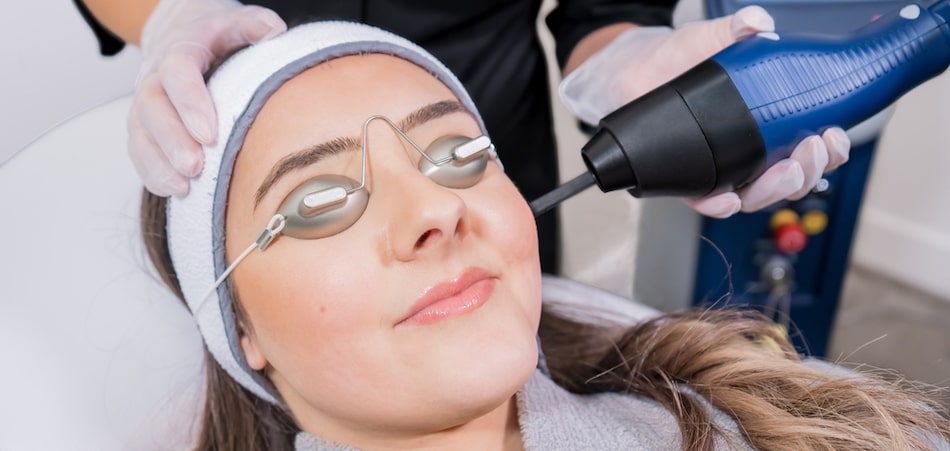
Your skin has several layers, and over time the layers are damaged by the sun, acne, or can lose their vibrancy due to aging. Removing the dead skin cells and damaged layers can expose fresh new skin. A way to eliminate these layers is with CO2 lasers, resurfacing the skin and removing years of damage from the skin.
Laser beams to the skin may sound extreme, but the advanced technology of CO2 lasers is what makes this treatment so effective. The laser's intense energy combined with quick short bursts, resurfaces the skin by vaporizing the top layers without damaging surrounding areas.
CO2 laser resurfacing doesn’t just help exfoliate the top layer of the skin, but the laser energy goes deeper into the skin's structure to stimulate the production of new collagen fibers making new skin that is smoother firmer over time.
So, what exactly are CO2 lasers, and what should you expect during the procedure and recovery time? We share all the details about this minimally invasive treatment that can take years off the skin.
Laser resurfacing is a non-surgical facial rejuvenation procedure that uses a high-energy light beam to improve the skin's texture, tone, or minor skin flaws such as warts and acne scars.
Laser resurfacing has two main laser types, ablative and non-ablative.
A CO2 laser is a carbon monoxide laser that creates a "controlled injury" to the skin by using a high-energy light beam. The energy targets the water in the top layer of the skin cells, causing them to vaporize and break down, without damaging the surrounding skin.
The latest CO2 lasers are fractional lasers that use very short-pulsed high-intensity energy (ultra-pulsed). The laser energy burst into thousands of tiny beams to treat only a fraction of the skin in a scanning pattern.
As the laser beam ablates the skin's surface, it continues to the deepest layers of the skin to activate new collagen production that will help the skin become more buoyant and firmer over time.
The damaged layers of the skin are wiped off immediately during the procedure but will take a minimum of 14 days for the skin to completely heal and regenerate new healthier skin.
By removing thin top layers of the skin, a CO2 laser treatment reveals an underlayer for a smoother texture and gets rid of skin irregularities such as:
A CO2 laser procedure is an outpatient doctor's visit that takes less than an hour to complete. The board-certified dermatologist may provide an option to apply a topical numbing cream to help reduce the discomfort of the laser beam’s short bursts.
During the procedure, the laser will pass over the skin sending out short pulses lasting less than a millisecond. The dermatologist will wipe the treated area with a saltwater solution between passes to cool the skin and remove the dead skin cells. The number of passes needed depends on the width of the areas being treated and the condition of the skin.
After the CO2 laser resurfacing, the treated skin will be raw, swollen, and itchy. The doctor will apply a thick ointment to the treated skin and cover the area with an airtight and watertight dressing.
The treated skin will dry out and self-exfoliate for the first 3 to 7 days after the procedure. During this time, patients typically avoid any social engagements because the skin will look red, patchy, and irritated as it is healing. The redness may turn brown and form crusts on the skin that generally peels off independently and should not be picked off. Picking at scabs can result in an infection or scarring.
The typical recovery time for a CO2 laser resurfacing treatment will take 14 to 18 days for the skin to heal and form new skin that is visibly smoother, tighter, and brighter tone with less pigmentation from old scars.
It's common for patients to undergo several treatments to achieve their desired results.
As the skin ages, the layers can become dull, wrinkled, and spotted from sun exposure or damaged from old acne flare-ups—the type of skin flaws that need a more aggressive treatment than with chemical peels or dermabrasions.
Skin resurfacing with CO2 lasers can easily remove these old layers of skin to reveal new smoother, and tighter skin. It does take 2-3 weeks to recover fully for final results to appear, but a few weeks of healing is worth taking years of damage off of the skin's surface.
To find a board-certified dermatologist experienced with CO2 Laser Resurfacing treatments use our “Find a Doctor” navigation tool for a medical professional in your area.
- VM